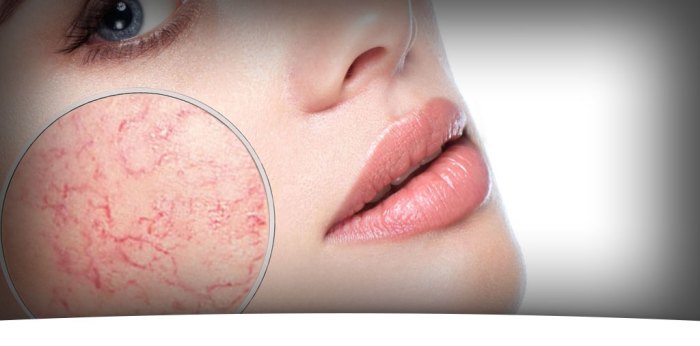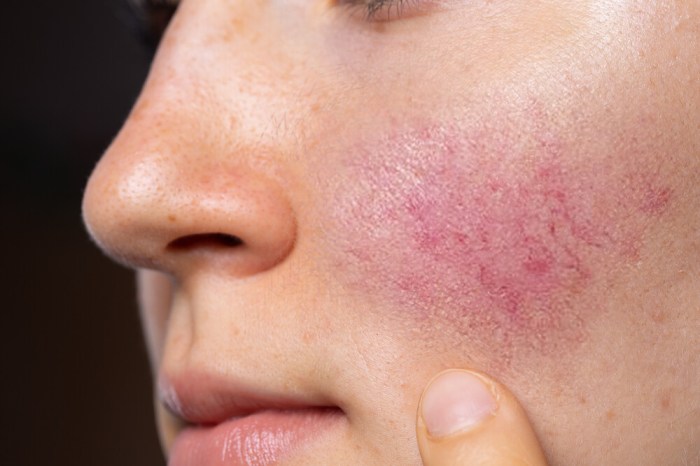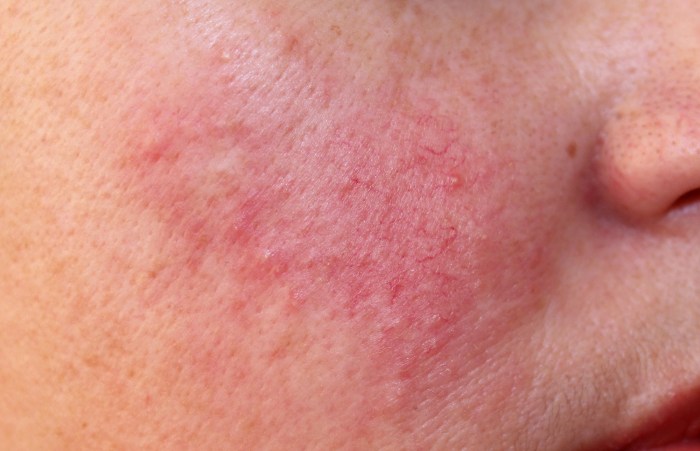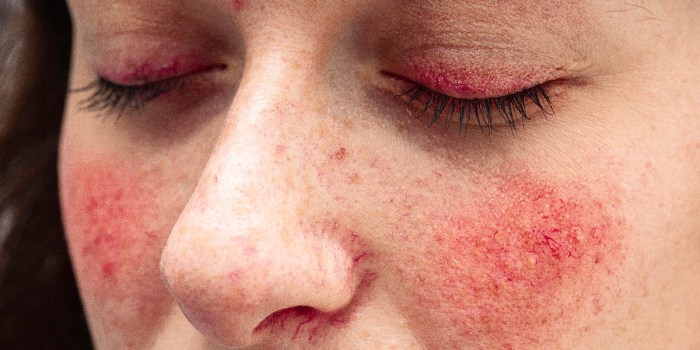Couperose skin is indicated by a distinctive pattern of visible blood vessels on the face, often accompanied by redness and inflammation. This condition, also known as rosacea, can be a source of discomfort and affect self-esteem. Understanding the characteristics, causes, and potential treatments for couperose skin is crucial for managing this condition effectively.
Couperose skin manifests in various forms, from mild flushing to more severe redness and visible blood vessels. The most common areas affected are the cheeks, nose, chin, and forehead. While the exact cause of couperose skin remains unknown, genetic factors, environmental triggers, and certain medical conditions are believed to play a role.
Couperose Skin Characteristics

Couperose skin, also known as rosacea, is a common skin condition characterized by visible blood vessels and redness on the face. It typically affects people with fair skin and is more prevalent in women than men.
The most noticeable symptom of couperose skin is the appearance of dilated blood vessels, which can be seen as fine red lines or spider veins on the skin’s surface. These blood vessels are often most visible on the cheeks, nose, chin, and forehead.
Common Areas
Couperose skin is most commonly found on the face, particularly on the cheeks, nose, chin, and forehead. These areas are more prone to redness and visible blood vessels due to their thin skin and increased exposure to environmental factors.
Causes of Couperose Skin: Couperose Skin Is Indicated By

Couperose skin, characterized by facial redness and visible blood vessels, can result from various factors. These include genetic predispositions, environmental influences, and underlying medical conditions.
Genetic Factors
Individuals with fair skin and a family history of couperose skin are more likely to develop this condition. Genetic variations in genes involved in skin barrier function, vascular regulation, and inflammation can contribute to the development of couperose skin. These genetic factors can lead to weakened blood vessels and impaired skin barrier function, making the skin more susceptible to redness and inflammation.
Environmental Factors
Exposure to environmental factors such as ultraviolet (UV) radiation from sunlight and extreme temperatures can trigger or worsen couperose skin. UV radiation can damage the skin’s collagen and elastin, leading to weakened blood vessels and increased skin sensitivity. Extreme temperatures, both hot and cold, can cause vasodilation (widening of blood vessels) and vasoconstriction (narrowing of blood vessels), respectively, which can contribute to facial redness.
Medical Conditions
Certain medical conditions can also increase the risk of developing couperose skin. These include rosacea, a chronic inflammatory skin condition characterized by facial redness, acne-like bumps, and dilated blood vessels; and autoimmune disorders such as lupus erythematosus, which can cause inflammation and damage to blood vessels in the skin.
Hormonal imbalances, particularly during pregnancy and menopause, can also contribute to the development of couperose skin due to increased blood flow to the face.
Treatment Options for Couperose Skin

Couperose skin can be managed through a combination of treatments, including laser therapy, topical medications, and lifestyle modifications.
Laser Treatments
Laser treatments are effective in reducing the appearance of couperose skin. Intense pulsed light (IPL) and pulsed dye laser (PDL) are commonly used laser therapies for couperose skin. IPL targets hemoglobin in the blood vessels, while PDL specifically targets the dilated capillaries.
Both treatments result in coagulation of the affected vessels, leading to their collapse and reduced visibility.
Topical Medications
Topical medications, such as creams and serums, can help improve the appearance of couperose skin. Ingredients like azelaic acid, vitamin C, and niacinamide have anti-inflammatory and antioxidant properties that can help reduce redness and strengthen the skin’s barrier.
Lifestyle Modifications
Lifestyle modifications can also contribute to improving couperose skin. Avoiding triggers like sun exposure, extreme temperatures, and alcohol consumption can help reduce inflammation. Adopting a healthy diet rich in fruits, vegetables, and whole grains can provide essential nutrients for skin health.
Couperose skin is indicated by red blotches and broken capillaries. It can also be a crossword clue that has a point, like this one . The answer is “needle”, which is sharp and has a point. Couperose skin is often caused by sun damage, so it’s important to protect your skin from the sun to prevent it.
Additionally, incorporating a gentle skincare routine that involves using fragrance-free, non-abrasive products can help minimize irritation and prevent further damage.
Prevention of Couperose Skin

Preventing couperose skin is crucial for maintaining a healthy and even complexion. Implementing proactive measures can help reduce the severity and frequency of flare-ups.
Sun Protection
Sun exposure is a major trigger for couperose skin, as it damages the blood vessels and worsens inflammation. Therefore, sun protection is paramount.
- Apply sunscreen with an SPF of 30 or higher daily, even on cloudy days.
- Wear protective clothing, such as hats and long sleeves, when outdoors.
- Seek shade during peak sun hours (10 am to 4 pm).
Avoiding Triggers, Couperose skin is indicated by
Identifying and avoiding triggers that can worsen couperose skin is essential for prevention.
- Extreme temperatures, both hot and cold, can cause blood vessels to dilate or constrict.
- Alcohol and caffeine can increase blood flow to the skin, making it more susceptible to flushing.
- Spicy foods and certain medications can also trigger flare-ups.
Healthy Diet and Exercise
Maintaining a healthy diet and engaging in regular exercise contribute to overall skin health.
- A diet rich in fruits, vegetables, and whole grains provides essential vitamins and antioxidants that support skin health.
- Regular exercise improves circulation, which can help reduce the appearance of couperose skin.
Q&A
What are the common triggers for couperose skin?
Sun exposure, extreme temperatures, spicy foods, alcohol, and certain skincare products can trigger couperose skin.
Can couperose skin be prevented?
While there is no guaranteed way to prevent couperose skin, practicing sun protection, avoiding triggers, and maintaining a healthy lifestyle can help minimize its severity.